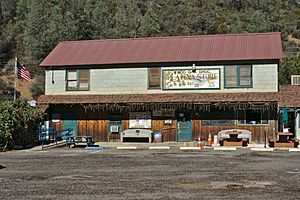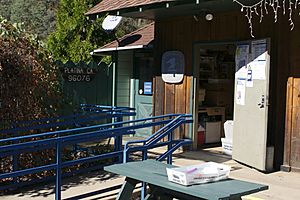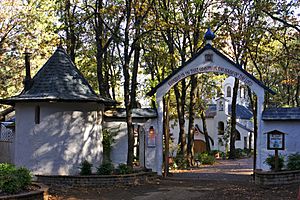Platina, California facts for kids
Quick facts for kids
Platina, California
|
|
|---|---|

Platina general store
|
|
| Country | United States |
| State | California |
| County | Shasta |
| Elevation | 2,277 ft (694 m) |
| Population
(2020)
|
|
| • Total | 13 |
| Time zone | UTC-8 (Pacific (PST)) |
| • Summer (DST) | UTC-7 (PDT) |
| ZIP code |
96076
|
| Area code(s) | 530 |
| GNIS feature ID | 264843 |
Platina is a very small, unincorporated community in Shasta County, California. An unincorporated community means it's a place with a shared identity, but it doesn't have its own local government like a city or town. It's located about 40 miles (64 km) west of both Redding and Red Bluff.
As of 2020, only 13 people lived in Platina. Its name comes from the Spanish word for "platinum". The area's ZIP code is 96076, and phone numbers start with 530-352.
Contents
History of Platina
Platina was first established in 1902. It was originally called Noble's Station, named after a local person named Don Noble. This spot was important because it was a stage stop. Stagecoaches would pause here on their journeys between Red Bluff and other small towns like Knob, Wildwood, Peanut, and Hayfork.
At Noble's Station, travelers could find a boarding house (a place to stay), a general store (where they could buy supplies), and a post office. These places were very helpful for people traveling through the area.
How Platina Got Its Name
In the 1920s, Don Noble and others made an exciting discovery. They found platinum in a nearby stream called Beegum Creek. Because of this discovery, Noble's Station quickly became known as "Platina." Platinum is a valuable metal, and the word "platina" can also refer to a natural mix of platinum with other similar metals.
The current Platina post office was opened in 1921. Today, both the post office and the general store are located in almost the same spot as the original Noble's Station buildings. The owners of the general store once tried to sell it and some other buildings in town online, but they were not successful.
Saint Herman of Alaska Monastery
Just south of Platina, you'll find the Saint Herman of Alaska Monastery. This is a special place where a group of monks from the Serbian Orthodox Church live and pray. It was started in 1968 by two monks, Father Herman Podmoshensky and Father Seraphim Rose. They had the blessing of a very respected religious leader, Saint John the Wonderworker.
Father Seraphim Rose was a very smart person. He went to college at Pomona College and the University of California at Berkeley. He later became a Russian Orthodox Christian and wrote many books. He also translated many old Orthodox texts. A lot of his writings were printed right at the monastery. Father Seraphim passed away on September 2, 1982, and is buried in the monastery's cemetery.
Many Orthodox Christians around the world deeply respect Father Seraphim. While he hasn't been officially recognized as a saint by all Orthodox churches, some local churches, like the Georgian Orthodox Church, have honored him as a saint.
Platina's Climate
Platina experiences a type of weather known as a warm-summer Mediterranean climate. This climate is often called "Csa" on climate maps. In this type of climate, summers are usually hot and dry, while winters are mild and wet.
| Climate data for Plantina, California | |||||||||||||
|---|---|---|---|---|---|---|---|---|---|---|---|---|---|
| Month | Jan | Feb | Mar | Apr | May | Jun | Jul | Aug | Sep | Oct | Nov | Dec | Year |
| Record high °F (°C) | 75 (24) |
78 (26) |
82 (28) |
91 (33) |
100 (38) |
106 (41) |
112 (44) |
110 (43) |
108 (42) |
98 (37) |
88 (31) |
75 (24) |
112 (44) |
| Mean maximum °F (°C) | 66 (19) |
68 (20) |
73 (23) |
79 (26) |
90 (32) |
99 (37) |
103 (39) |
102 (39) |
99 (37) |
90 (32) |
77 (25) |
64 (18) |
103 (39) |
| Mean daily maximum °F (°C) | 49.5 (9.7) |
52.9 (11.6) |
57.5 (14.2) |
63.3 (17.4) |
72.5 (22.5) |
82.8 (28.2) |
91.5 (33.1) |
90.7 (32.6) |
85.3 (29.6) |
72.9 (22.7) |
56.7 (13.7) |
49.3 (9.6) |
68.7 (20.4) |
| Daily mean °F (°C) | 40.8 (4.9) |
43.2 (6.2) |
47.1 (8.4) |
51.7 (10.9) |
59.4 (15.2) |
67.3 (19.6) |
74.2 (23.4) |
72.8 (22.7) |
65.3 (18.5) |
55.6 (13.1) |
46.8 (8.2) |
40.6 (4.8) |
55.4 (13.0) |
| Mean daily minimum °F (°C) | 32.2 (0.1) |
33.6 (0.9) |
36.7 (2.6) |
40.1 (4.5) |
46.2 (7.9) |
51.9 (11.1) |
55.8 (13.2) |
55.0 (12.8) |
45.2 (7.3) |
38.4 (3.6) |
36.9 (2.7) |
31.9 (−0.1) |
42.0 (5.6) |
| Mean minimum °F (°C) | 20 (−7) |
21 (−6) |
21 (−6) |
24 (−4) |
30 (−1) |
34 (1) |
43 (6) |
44 (7) |
37 (3) |
30 (−1) |
24 (−4) |
20 (−7) |
17 (−8) |
| Record low °F (°C) | 4 (−16) |
−2 (−19) |
13 (−11) |
12 (−11) |
21 (−6) |
17 (−8) |
28 (−2) |
34 (1) |
25 (−4) |
18 (−8) |
11 (−12) |
−3 (−19) |
−3 (−19) |
| Average precipitation inches (mm) | 6.48 (165) |
5.06 (129) |
5.10 (130) |
2.42 (61) |
2.04 (52) |
0.70 (18) |
0.13 (3.3) |
0.11 (2.8) |
0.24 (6.1) |
1.75 (44) |
3.42 (87) |
7.91 (201) |
35.36 (899.2) |
| Average snowfall inches (cm) | 6.8 (17) |
3.3 (8.4) |
3.2 (8.1) |
0.4 (1.0) |
0.0 (0.0) |
0.0 (0.0) |
0.0 (0.0) |
0.0 (0.0) |
0.0 (0.0) |
0.0 (0.0) |
1.0 (2.5) |
5.4 (14) |
20.1 (51) |
| Source: NOAA | |||||||||||||





